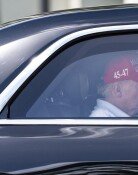To Prevent Betrayal, Hussein Carried a Large Amount of Cash
To Prevent Betrayal, Hussein Carried a Large Amount of Cash
Posted December. 21, 2003 23:07,
The New York Times reported on December 21 that Saddam Hussein, before being caught by the U.S. military, spent several months moving among 20 or 30 safe houses in Tikrit, and was kept informed of the internal situation by his loyal followers.
Hussein traveled on foot and by small boat along the Tigris River, and along the back roads in an ever-changing mix of cars, taxis and pickup trucks, the New York Times added.
According to U.S. military officers, Hussein fled north, driving a Volkswagen Passat, immediately after April 9, the day of the fall of Baghdad. At his hometown of Tikrit, his family and tribal members, who associated with him before his seizure of power, sheltered him. Although he stayed as long as a week at a place if it seemed safe, he occasionally moved on with two or three confidential followers.
Since the U.S. military offered a $25 million reward, Hussein carried a number of $100 bills to prevent betrayal. He was caught with $750,000. His options were narrowing as his cash drained away, along with his access to whatever foreign bank accounts that escaped being frozen, the New York Times added.
Lt. Col. Todd Megill, intelligence officer for the Fourth Infantry Division at Tikrit, which carried out the raid to get Hussein, said that Husseins supporters were not weapon experts educated in western countries but were people from the top five organizations.
According to the New York Times, the crucial man for Hussein was a middle-aged massive 135 kg figure from the Special Security Organization, one of the most feared organizations under Husseins rule. This man, one of the most crucial five supporters, was caught in Baghdad on December 12 and revealed information of Hussein whereabouts on December 13 after intense interrogations.
To grasp the network of Husseins supporters, U.S. military information authority has made a chart of every person connected to Hussein, about 9,000 people, since June. The most crucial five supporters, however, were not included among the most wanted 55 men.
Informers in Iraq and electronic wiretappings helped the U.S. to arrest the person who had decisive information of Husseins refuge.
Kwan-Hee Hong konihong@donga.com
Headline News
- Yoon removed from office by unanimous court decision
- Constitutional Court mentions responsibility of both Yoon and National Assembly
- Won-dollar rate falls to 1,430 range after impeachment ruling
- Teacher with spinal cord injury transforms into career counselor
- U.S. redeploys Patriot missiles from S. Korea without replacement forces







